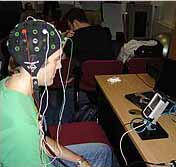Computer Users Move Themselves with the Mind
by Michael Hopkin
 A
device called a brain-computer interface detects activity in certain brain
areas linked to movement, and uses the signals to mimic that movement
in a virtual world.
A
device called a brain-computer interface detects activity in certain brain
areas linked to movement, and uses the signals to mimic that movement
in a virtual world.
"Just thinking about movement activates the same neurons as actually moving," explains Gert Pfurtscheller of Graz University of Technology in Austria, who has been working on the device for around four years. By picking up on these bursts of nerve activity, the computer can decide whether you are thinking about moving your hands or feet, and react accordingly.
The technology detects brain waves by using electrodes placed at strategic points on the scalp; they are positioned over brain areas known to be involved in moving specific body parts. The computer can then distinguish between signals corresponding to different types of movement.
Previously, accurate detection of local brain activity has required electrodes to be implanted in the brain. This technique has allowed recipients to control robots and even send e-mails. The new device, presented at the Presence 2005 technology meeting in London last week, achieves a similar feat using non-invasive methods.
The team tested their creation by asking participants to navigate a virtual-reality studio called the Virtual Cave. Test subjects sit in a square studio wearing three-dimensional goggles, which project a scene such as a street, complete with pedestrians and buildings.
The computer then chooses a task for the participant: either walking forwards or moving their hands. It tells the user what to do through sound cues.
If the person is asked to think about walking, and they do so in a way that can be picked up by the cap, the virtual character steps forwards. If they fail, the character stays still. One of the world's best-trained users is Doris Zimmerman, a student who has worked extensively with the team in Austria. She was flown in to help with demonstrations at the conference. As she sits in front of the Virtual Cave's three-dimensional screen, we watch her effortlessly glide down a street.
But after enough training, the team hopes that the virtual device could help those who are unable to move to interact more easily with others. It could even enable stroke patients to regain movement, Pfurtscheller hopes, by allowing them to 'exercise' their brain's motor centres.
"If they think of moving their hand and they see a hand move, it reinforces the thought," he says. And strengthening the mind, he adds, might lead to better motor control.
Excerpt from news@nature.com, September 27, 2005